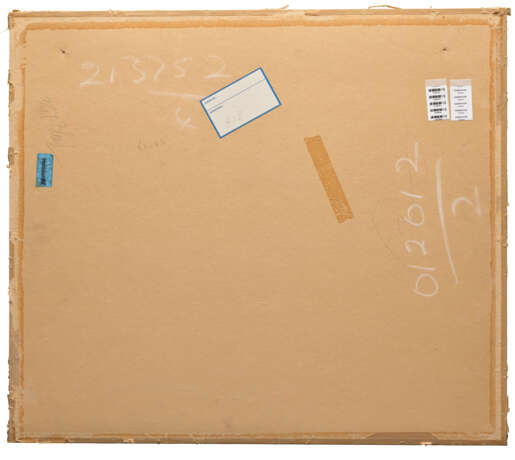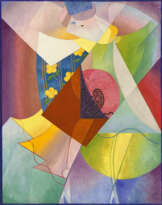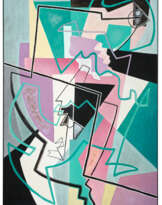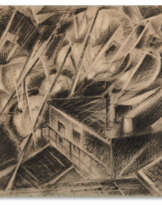ID 930199
Лот 117 | Gino Severini (1883-1966)
Оценочная стоимость
€ 100 000 – 150 000
Le Compotier
signé 'G. Severini' (en bas à droite)
papiers collés, carton ondulé, gouache, fusain et graphite sur papier
50.7 x 61.5 cm.
Exécuté vers 1918
signed 'G. Severini' (lower right)
paper collage, corrugated carboard, gouache, charcoal and pencil on paper
20 x 24 1/4 in.
Executed circa 1918
Provenance
Marguerite Maud Savary, Paris (probablement acquis auprès de l'artiste).
Vente, Sotheby & Co, Londres, 29 novembre 1972, lot 66.
Fischer Fine Art Ltd, Londres (acquis au cours de cette vente).
Acquis auprès de celle-ci par le propriétaire actuel.
Literature
D. Fonti, Gino Severini, Catalogo ragionato, Milan, 1988, p. 271, no. 309 (illustré).
Special notice
Artist's Resale Right ("droit de Suite").
If the Artist's Resale Right Regulations 2006 apply to this lot, the buyer also agrees to pay us an amount equal to the resale royalty provided for in those Regulations, and we undertake to the buyer to pay such amount to the artist's collection agent.
ƒ: In addition to the regular Buyer’s premium, a commission of 5.5%
inclusive of VAT of the hammer price will be charged to the buyer.
It will be refunded to the Buyer upon proof of export of the lot
outside the European Union within the legal time limit.
(Please refer to section VAT refunds)
Post lot text
"Il a été - et c'est là son originalité, voire, sans doute, sa grandeur - le pont entre le futurisme et le cubisme".
B. Dorival, cité dans Futurisme, cat. exp., Tate Modern, Londres, 2009, p. 242.
En 1912, Gino Severini, un des chefs de file du Futurisme italien, vit à Paris, au moment où Pablo Picasso et Georges Braque
commencent à coller des morceaux de papiers découpés pour créer leurs œuvres cubistes. Ces expérimentations de collage ou de papier-collé ont rapidement été intégrées au récit historique du cubisme synthétique, un style que Severini adopte rapidement à la fin de sa période Futuriste.
Les séries de natures mortes que Severini réalise en 1916-18 témoignent d’un développement remarquable de son travail vers une construction cubiste de ses compositions. Le mouvement Futuriste, en tant qu’entité artistique, avait pris fin au début de la guerre, en 1914. Durant la période qui suivit, Severini développe alors un traitement plus plat des formes; fondé sur les rapports de proportionnalité explorés par les artistes cubistes. À travers le Cubisme, Severini concentre son art autour de ce qu’il nommait le « mouvement universel », dans lequel il construit et déconstruit l’espace physique dans une pratique rationnelle et géométrique. Dans son autobiographie, Severini explique comment il a commencé à abandonner l’étude des objets et des figures en mouvement après 1914, devenant presque automatiquement attiré par des formes solides et par un concept de construction de la composition, et créant finalement une synthèse entre les deux : « Mon idée, qui était partagée par de nombreux cubistes et approuvée par Matisse lui-même, était de porter l’expression artistique à un niveau qui réconcilierait le désir d'extrême vitalité (le dynamisme) des futuristes avec les intentions de construction, de classicisme, et de style utilisées par les Cubistes» (G. Severini, La Vita, Rome, 1983, p. 208).
Dans ses séries de collages, des blocs de formes géométriques se chevauchent ou se masquent afin de construire des objets de nature morte. Dans Le Compotier, de nombreux effets de trompe-l'œil sont obtenus grâce à l’utilisation de motifs désormais devenus des icônes de l’art cubiste : un compotier, un verre et une bouteille posés sur une table rudimentaire. Ensemble, ils créent un motif magnifiquement serein et harmonieux, un savant mélange de sujets figuratifs découpés et peints.
“He was - and this was his originality, even, doubtless, his greatness - the bridge between Futurism and Cubism.”
B. Dorival, quoted in Futurism, exh. cat., Tate Modern, London, 2009, p. 242.
A leader of Italian Futurism, Severini was living in Paris in 1912 when Pablo Picasso and Georges Braque began to paste pieces of cut paper onto their Cubist works. These papier-collé or collage experiments were soon absorbed into the art historical narrative of Synthetic Cubism, a style which Severini was quick to adopt at the end of his Futurist period.
The series of still-lifes Severini executed in 1916-18 charter a remarkable development in his work towards a Cubist construction of the composition. The Futurist movement as an artistic entity had come to an end with the outbreak of the war in 1914 and in the period that followed Severini developed a planer treatment of form based on proportionate relations explored by the Cubist artists. Severini focused his art on what he called the 'universal movement' through Cubism, in which he constructed and deconstructed physical space in a rational and geometrical practice. In his autobiography Severini noted how he began to abandon the study of objects and figures in motion after 1914, becoming drawn almost automatically towards solid forms and to the concept of the construction of the composition, and ultimately creating a synthesis between them: 'My idea, which was shared by many Cubists and approved by Matisse himself, was to carry artistic expression to a level that reconciles the desire for extreme vitality (dynamism) of the Futurists with the intention of construction, of classicism, and of the style used by Cubists' (G. Severini, La Vita, Rome, 1983, p. 208).
In his series of collages, blocks of geometric forms overlap or are elided to construct still-life elements. In Le Compotier, numerous trompe-l’œil effects are achieved through the use of motifs that have now become icons of cubist art: a fruit bowl, a glass and a bottle all set on a schematic table. Together they create a beautifully serene and harmonious patterning, a mixing and matching of cut-out and painted-in figurative subjects.
| Автор: | Джино Северини (1883 - 1966) |
|---|---|
| Техника исполнения: | Гуашь, Уголь, Коллаж |
| Материал: | Акриловое стекло, Дерево, Пластик |
| Жанр: | Натюрморт |
| Автор: | Джино Северини (1883 - 1966) |
|---|---|
| Техника исполнения: | Гуашь, Уголь, Коллаж |
| Материал: | Акриловое стекло, Дерево, Пластик |
| Жанр: | Натюрморт |
| Адрес торгов |
CHRISTIE'S 9 Avenue Matignon 75008 Paris Франция | ||||||||||||||
|---|---|---|---|---|---|---|---|---|---|---|---|---|---|---|---|
| Предосмотр |
| ||||||||||||||
| Телефон | +33 (0)1 40 76 85 85 | ||||||||||||||
| Факс | +33 (0)1 40 76 85 86 | ||||||||||||||
| Условия использования | Условия использования | ||||||||||||||
| Транспортировка |
Почтовая служба Курьерская служба Самовывоз | ||||||||||||||
| Способы оплаты |
Банковский перевод | ||||||||||||||
| Часы работы | Часы работы
|
















